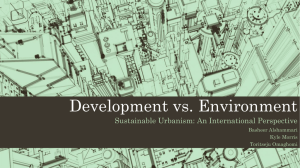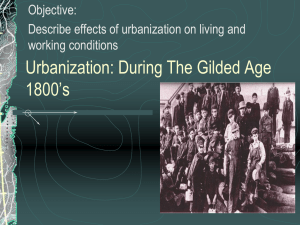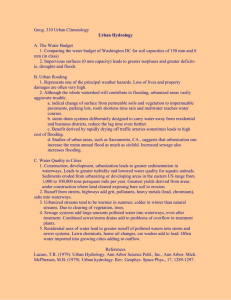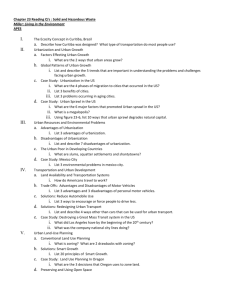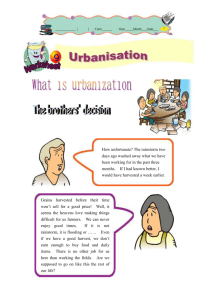Development-vs-Environment lessons learned
advertisement
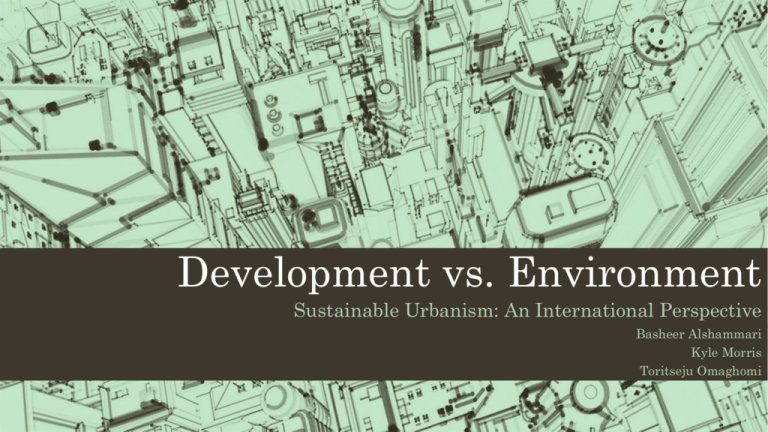
Development vs. Environment Sustainable Urbanism: An International Perspective Basheer Alshammari Kyle Morris Toritseju Omaghomi OUTLINE • Definition of Development • Types of development and how it is measured • Benefits of Urbanization • The Underlying Issue • Effects of urbanization on the environment • Examples of effects • Balancing the scales and learning from experience • Benefits of learning • What we hope to learn Development is a state of growth or advancement • Economic growth is the increase in total value of goods and services produced. • Measured in Gross Domestic Product (GDP), Gross National Product (GNP), per capita income etc. • Top 5 GDP in the world • United States, China, Japan , Germany, France • Development is an improvement in human welfare, quality of life, social wellbeing by satisfying the populations needs and wants • Measure by socio-economic indicators (population growth, education, employment, housing and amenities, economic indices etc.) • Sustainable development is the type of development that addresses the populations present need without jeopardizing the ability of the future generations to meets its own need. • Measured using indicators of environmental quality (air quality, water quality, amount of waste generated etc.) • Lessen adverse impact on environment • Conservation of nonrenewable resources • Lower carbon footprint Benefits of Economic Development The Underlying Issue • hvuy Effects of urbanization on the environment Air – Increased Temperature Land – Increased Runoff Effects of urbanization on the environment Water –Increased water pollution Effects of urbanization on the environment • Water –Flooding Effects of urbanization on the environment • Water –Sewer Overflow Effects of urbanization on the Environment • Some effects are not caused by urbanization. However, because of urbanization, the number of people at risk increases. • Port cities with a population of over 1 million have the highest population exposure to flood. • Other natural hazard such as earthquake, fire outbreak, even health hazards Examples of the effects of urbanization • London Smog (1952 Winter) • Coal fired induced smog • Respiratory issues (4000 died within 4 days; 8000 within 2 months) • Addressed by building taller chimneys that resulted in trans-border issues :Acid rain • Los Angeles (1955) • Photochemical smog from car exhaust • Affect both plants and human alike • Caused death by respiratory failure • Japan (1956) • Minamata Disease • Toxic chemicals not disposed properly • Led to severe mercury poisoning / http://blog.hemmings.com/index.php/2012/04/18/los-angeles-1955-2 Examples of the effects of urbanization • Manila, Philippines (2012) • 12 days rainfall (seasonal monsoon) • Submerged 50% of Manila • Over 1 million squatters were forced to seek refuge else were- due to poor planning http://www.unisdr.org/archive/27965 Desertification; Sand Dune Moving • North Africa, Middle East • Caused by removing vegetation by the wind. • ُ Threats urban, ports, Airports farms, Examples of the effects of urbanization • Jeddah, Saudi Arabia, Flooding (2011) • 3 days heavy rainfall. • Damaged %70 of the infrastructure • %25 lost their houses. • Diseases, Malaria ،Cholera ،Typhoid • Complete paralysis Pros and Cons of Rapid Urbanization • Pros • Growth in industrial productions • Trade and Commerce • Tourism • Technology • Cons • Housing issues • Agriculture • Environment • Water and sanitation treatment • Air quality • Unforeseen issues Solutions • Clear Water Infrastructure Sustainability Policy (US) • Clean Air Act (UK) • Energy-saving technology • Development of new energy sources • Circular Economy Promotion Law • Cap & Trade • Carbon/ Emissions tax Balancing the Scales DEVELOPEMENT ENVIRONMENT “Although beneficial accidents are rare, we can prepare for what they unveil by honing our own skills and learning from others experience.” Unknown quotes Resolutions • Adoption of strict water policies • Continued state family policies • Practice of sustainable agriculture in rural areas • Encourage research on energy efficient procedures • Reduce carbon emissions by improving carbon capture/sequestration References • http://blog.airdye.com/goodforbusiness/2010/01/25/china-pollution-and-textiles-acotton-problem/ • http://blog.hemmings.com/index.php/2012/04/18/los-angeles-1955-2/ • http://www.ec.gc.ca/eau-water/default.asp?lang=En&n=72FDC156-1 • http://www.docstoc.com/docs/48541752/Is-Urbanization-the-Cause-of-EnvironmentalDegradation • http://www.citiesalliance.org/sites/citiesalliance.org/files/CA_Images/IFRC-WDR2010full.pdf Lessons learning • Basheer Alshammari • Kyle Morris • May 20th, 2013 What we have learned: • China is truly growing at a rapid pace • Learning lessons from past failures of urbanization from other countries • Developing better flooding systems to amend for previous disaster • Development of transportation and residency are the most important problems that need the most development. • Development of tourism sites to be most attractive by adding some other language beside Chinese and English. • We learned how speed train contributes in solving traffic problems. • Subway also useful way to solve transportation problems. • Planning large scale city is not tough task if we fellow scientific methods. • Housing methods in very large scale cities can be solution to high demand from residents.

